Please login or register to read the rest of this content.
Please login or register to read the rest of this content.
While this isn’t actually an air-pressure experiment but more of an activity in density, really, it’s still a great visual demonstration of why Hot Air Balloons rise on cold mornings.
Imagine a glass of hot water and a glass of cold water sitting on a table, side by side. Now imagine you have a way to count the number of water molecules in each glass. Which glass has more water molecules?
The glass of cold water has way more molecules… but why? The cold water is more dense than the hot water. Warmer stuff tends to rise because it’s less dense than colder stuff and that’s why the hot air balloon in experiment 1.10 floated up to the sky.
Clouds form as warm air carrying moisture rises within cooler air. As the warm, wet air rises, it cools and begins to condense, releasing energy that keeps the air warmer than its surroundings. Therefore, it continues to rise. Sometimes, in places like Florida, this process continues long enough for thunderclouds to form. Let’s do an experiment to better visualize this idea.
When air moves, the air pressure decreases. This creates a lower air pressure pocket right between the cans relative to the surrounding air. Because higher pressure pushes, the cans clink together. Just remember – whenever there’s a difference in pressure, the higher pressure pushes.
You will need about 25 straws and two empty soda cans or other lightweight containers
Rotor kites (often called UFO kites) are one of those unusual kites that require more complex aerodynamics in order to fly. This particular kite flies only when rotating. Make sure you have lots of wind for this kite by either visiting the beach or tying it to your bicycle.
This kite is very picky about wind speed. Make sure the string doesn’t rub on the plates during flight. You can use hollow gardening stakes, empty ballpoint pen tubes taped together into a long straw, or composite tubes instead of the straws described here. Fishing line or nylon string works for kite line as well.
Materials: Two straws, a long length of string (20 feet or more), duct tape, two foam plates (at least 4 inches in diameter, one 6x4-inch clean foam meat tray, hot glue gun, and scissors.
Here's what you do:
Rotor kites (often called UFO kites) are one of those unusual kites that require more complex aerodynamics in order to fly. This particular kite flies only when rotating. Make sure you have lots of wind for this kite by either visiting the beach or tying it to your bicycle.
This kite is very picky about wind speed. Make sure the string doesn’t rub on the plates during flight. You can use hollow gardening stakes, empty ballpoint pen tubes taped together into a long straw, or composite tubes instead of the straws described here. Fishing line or nylon string works for kite line as well.
Materials: Two straws, a long length of string (20 feet or more), duct tape, two foam plates (at least 4 inches in diameter, one 6x4-inch clean foam meat tray, hot glue gun, and scissors.
Here's what you do:
You’re about to play with one of the first methods of underwater breathing developed for scuba divers hundreds of years ago.! Back then, scientists would invert a very large clear, bell-shaped jar over a diver standing on a platform, then lower the whole thing into the water. Everyone thought this was a great idea, until the diver ran out of breathable air…
Materials: 12″ flexible tubing, two clear plastic cups, bathtub
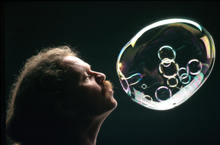
Click here for a printer-friendly version of this page.
Objective If you’re fascinated by the simple complexity of the standard soap bubble, then this is the lab for you. You can easily transform these ideas into a block-party Bubble Festival, or just have extra fun in the nightly bathtub. Either way, your kids will not only learn about the science of water, molecules, and surface tension, they’ll also leave this lab cleaner than they started (which is highly unusually for science experiments!)
About the Experiments The absolute best time to make gigantic bubbles is on an overcast day, right after it rains. Bubbles have a thin cell wall that evaporates quickly in direct sun, especially on a low-humidity day. If you live in a dry area with low-humidity, be sure to use glycerin. The glycerin will add moisture and deter the rapid thinning of the bubble’s cell wall (which cause bubbles to tear and pop).
The How and Why Explanation If you pour a few droplets of water onto a sweater or fabric, you’ll notice that the water will just sit there on the surface in a ball (or oval, if the drop is large enough). If you touch the ball of water with a soapy finger, the ball disappears into the fibers of the fabric! What happened?
Soap makes water “wetter” by breaking down the water’s surface tension by about two-thirds. Surface tension is the force that keeps the water droplet in a sphere shape. It’s the reason you can fill a cup of water past the brim without it spilling over. Without soap, water can’t get into the fibers of your clothes to get them clean. That’s why you need soap in the washing machine.
Soap also makes water stretchy. If you’ve ever tried making bubbles with your mouth just using spit, you know that you can’t get the larger, fist-sized spit bubbles to form completely and detach to float away in the air. Spit is 94% water, and water by itself has too much surface tension, too many forces holding the molecules together. When you add soap to it, they relax a bit and stretch out. Soap makes water stretch and form into a bubble.
The soap molecule looks a lot like a snake; it’s a long chain that has two very different ends. The head of the snake loves water, and the tail loves dirt. When the soap molecule finds a dirt particle, it wraps its tail around the dirt and holds it.
The different colors of a soap bubble come from how the white light bounces off the bubble into your eye. Some of the light bounces off the top surface of the bubble and bends only a little bit, while the rest passes through the thin film and bounces off the inner surface of the bubble and refracts more.
If you made the Hover Bubbles, you’ll notice that the bubbles slowly get larger the longer they live in the tank. Remember that the bubble is surrounded by CO2 gas as it sinks. The bubble grows because carbon dioxide seeps through the bubble film faster than the air seeps out, as CO2 is more soluble in water than air (meaning that CO2 mixes more easily with water than air does).
Questions to Ask
A pulsar is a specific type of neutron star, so let’s start there. Neutron stars are made when a star slightly more massive than our Sun dies and goes supernova. In a supernova event, large amounts of radiation explodes out from the star, causing a brilliant flash of light which can sometimes outshine an entire galaxy.
At the same time, gravity causes the core of the star to collapse into a neutron star. Neutron stars are made almost entirely of neutrons (hence the name), and are MUCH smaller in size than their parent stars. Since a neutron star keeps most of the angular momentum from its parent star but has a significantly smaller radius, it spins with very high rotational speeds. These speeds typically lead to rotational periods ranging from milliseconds to seconds.
In addition to spinning quickly, neutron stars also commonly have very strong magnetic fields that can accelerate electromagnetic particles and eject them out along the magnetic poles of the star at extremely high velocities. This results in neutron stars emitting spinning beams of radiation, or light.
This project is for advanced students.This is one of the coolest applications of renewable energy to come about in recent years. BEAM stands for Biology, Electronics, Aesthetics, and Mechanics. It basically refers to a class of robots that instead of having complicated brains, rely on nervous-system type of sensors to interact with their world.
Some BEAM robots skitter, dance, flash, jump, roll, or walk, and most are solar powered. The result is a fast responding robot made of old cell phone parts that can fit inside your hand. We’ll be making a few different types so you can get a good handle on this type of programming-free, battery-free robotics.
Most BEAM robots use the same solar ‘engine’. The solar cell will convert sunlight into electricity, which will then be stored in our capacitors (think ‘electricity tanks’) until a certain threshold is reached… when the tanks are full, the robot begins to move. This means that you can leave them out all day, and they will sit and collect energy, then turn on by themselves until they run out of juice, then turn off, sit and recharge until they have enough energy to go again… and off they go!
Let’s walk through how to make a BEAM robot. Once you’ve got the hang of it, make a second solar engine from the rest of your parts and add any kind of body you want!
This project is for advanced students.This Stirling Engine project is a very advanced project that requires skill, patience, and troubleshooting persistence in order to work right. Find yourself a seasoned Do-It-Yourself type of adult (someone who loves to fix things or tinker in the garage) before you start working on this project, or you’ll go crazy with nit-picky things that will keep the engine from operating correctly. This makes an excellent project for a weekend.
Developed in 1810s, this engine was widely used because it was quiet and could use almost anything as a heat source. This kind of heat engine squishes and expands air to do mechanical work. There’s a heat source (the candle) that adds energy to your system, and the result is your shaft spins (CD).
This engine converts the expansion and compression of gases into something that moves (the piston) and rotates (the crankshaft). Your car engine uses internal combustion to generate the expansion and compression cycles, whereas this heat engine has an external heat source.
This experiment is great for chemistry students learning about Charles’s Law, which is also known as the Law of Volumes, which describes how gases tend to expand when they are heated and can be mathematically written like this:

where V = volume, and T = temperature. So as temperature increases, volume also increases. In the experiment you’re about to do, you will see how heating the air causes the diaphragm to expand which turns the crank.
Note: Brian Cox has created a BEAM Bot kit as an alternative BEAM project.
Brian's BEAM BOT is modeled after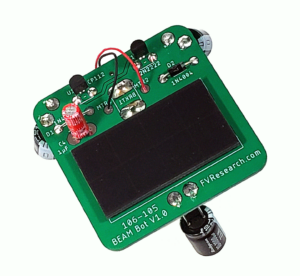 small BEAM projects where parts are soldered to each other, but such projects can be difficult to solder.
small BEAM projects where parts are soldered to each other, but such projects can be difficult to solder.
BEAM Bot uses a standard Printed Circuit Board (PCB) as the frame thus making it easier to assemble.
You can order Brian's BEAM Bot Kit here: fvresearch.com/product/beam-bot .
Click here for Brian's BEAM Bot instructional video (which can be found under Unit 25).
This project is for advanced students.This is one of the coolest applications of renewable energy to come about in recent years. BEAM stands for Biology, Electronics, Aesthetics, and Mechanics. It basically refers to a class of robots that instead of having complicated brains, rely on nervous-system type of sensors to interact with their world.
Some BEAM robots skitter, dance, flash, jump, roll, or walk, and most are solar powered. The result is a fast responding robot made of old cell phone parts that can fit inside your hand. We'll be making a few different types so you can get a good handle on this type of programming-free, battery-free robotics.
Note: Brian Cox has created a BEAM Bot kit as an alternative to the Trimet project.
Brian's BEAM BOT is modeled after small BEAM projects where parts are soldered to each other, but such projects can be difficult to solder.
small BEAM projects where parts are soldered to each other, but such projects can be difficult to solder.
BEAM Bot uses a standard Printed Circuit Board (PCB) as the frame thus making it easier to assemble.
You can order Brian's BEAM Bot Kit here: fvresearch.com/product/beam-bot .
Click here for Brian's BEAM Bot instructional video (which can be found under Unit 25).
This project is for advanced students. This is one of the coolest applications of renewable energy to come about in recent years. BEAM stands for Biology, Electronics, Aesthetics, and Mechanics. It basically refers to a class of robots that instead of having complicated brains, rely on nervous-system type of sensors to interact with their world.
Some BEAM robots skitter, dance, flash, jump, roll, or walk, and most are solar powered. The result is a fast responding robot made of old cell phone parts that can fit inside your hand. We'll be making a few different types so you can get a good handle on this type of programming-free, battery-free robotics.
You'll need to get the Trimet Kit from Solarbotics. It has everything you need except the tools for the job (soldering iron, pliers, wire strippers, razor) and paperclips.
Here's what you do:
This project is for advanced students.This is one of the coolest applications of renewable energy to come about in recent years. BEAM stands for Biology, Electronics, Aesthetics, and Mechanics. It basically refers to a class of robots that instead of having complicated brains, rely on nervous-system type of sensors to interact with their world.
Some BEAM robots skitter, dance, flash, jump, roll, or walk, and most are solar powered. The result is a fast responding robot made of old cell phone parts that can fit inside your hand. We’ll be making a few different types so you can get a good handle on this type of programming-free, battery-free robotics.
 If you’ve got an adult who made Estes Rockets as a kid, you’ll definitely want their help when you start your own. The excitement that building rockets creates, the passion that you both can share… it will make your rocketry adventure that much more memorable.
If you’ve got an adult who made Estes Rockets as a kid, you’ll definitely want their help when you start your own. The excitement that building rockets creates, the passion that you both can share… it will make your rocketry adventure that much more memorable.
Suppose you already have your adult helper (if not, stop here and get one. You really can’t do this without adult help, because this project involves FIRE.) The first thing you need to do is order your Alpha Rocket Kit. You can order one online or find one at your local hobby shop.
Since this experiment is a Bonus Experiment (it’s a more expensive project, and the parts are not typically in your local grocery store or hardware store…), the materials required are not listed with the main supplies for this set.
Please login or register to read the rest of this content.
Rockets shoot skyward with massive amounts of thrust, produced by chemical reaction or air pressure. Scientists create the thrust force by shoving a lot of gas (either air itself, or the gas left over from the combustion of a propellant) out small exit holes out the back of the nozzles.
Here are two videos of real rockets being tested. The second video uses a special type of photography to see the shock waves (you will learn more about how that's done in Unit 9).
For every action, there is equal and opposite reaction. If flames shoot out of the rocket downwards, the rocket itself will soar upwards. It’s the same thing if you blow up a balloon and let it go—the air inside the balloon goes to the left, and the balloon zips off to the right. They both follow Newton's Third Law: for every action, there is an equal and opposite reaction.
What you're looking at in the video below is exactly the kind of work I did as a graduate student in college when I was 21. The end of a rocket nozzle is on the right side, and you're looking at supersonic air (made visible by a special type of photography called 'Schlieren') as a rushes past from right to left. The thick white lines are shock waves, which are lines where the pressure drop is huge. When the flow is fast enough (around Mach 2 and up), you'll see nicely shaped 'Mach Diamonds' form.
Scientists use these images to tell how well the engines will perform at high-speed flight. One of the greatest aeronautical engineers, Kelly Johnson, who founded Skunkworks at Lockheed, said the greatest compliment he ever received was when a friend commented: "It's amazing... he can actually see airflow." This is what Johnson could visualize in his mind simply because he understood the fundamentals of aerodynamics:
An electrical circuit is like a raceway or running track at school. The electrons (racecars) zip around the race loop (wire circuit) superfast to make stuff happen. Although you can’t see the electrons zipping around the circuit, you can see the effects: lighting up LEDs, sounding buzzers, clicking relays, etc.
There are many different electrical components that make the electrons react in different ways, such as resistors (limit current), capacitors (collect a charge), transistors (gate for electrons), relays (electricity itself activates a switch), diodes (one-way street for electrons), solenoids (electrical magnet), switches (stoplight for electrons), and more. We’re going to use a combination diode-light-bulb (LED), buzzers, and motors in our circuits right now.
A CIRCUIT looks like a CIRCLE. When you connect the batteries to the LED with wire and make a circle, the LED lights up. If you break open the circle, electricity (current) doesn’t flow and the LED turns dark.
LED stands for “Light Emitting Diode”. Diodes are one-way streets for electricity – they allow electrons to flow one way but not the other.
Remember when you scuffed along the carpet? You gathered up an electric charge in your body. That charge was static until you zapped someone else. The movement of electric charge is called electric current, and is measured in amperes (A). When electric current passes through a material, it does it by electrical conduction. There are different kinds of conduction, such as metallic conduction, where electrons flow through a conductor (like metal) and electrolysis, where charged atoms (called ions) flow through liquids.
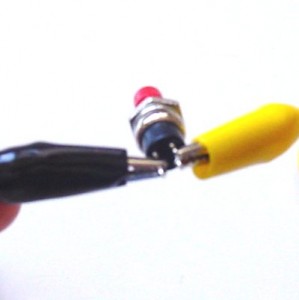 Make yourself a grab bag of fun things to test: copper pieces (nails or pipe pieces), zinc washers, pipe cleaners, Mylar, aluminum foil, pennies, nickels, keys, film canisters, paper clips, load stones (magnetic rock), other rocks, and just about anything else in the back of your desk drawer.
Make yourself a grab bag of fun things to test: copper pieces (nails or pipe pieces), zinc washers, pipe cleaners, Mylar, aluminum foil, pennies, nickels, keys, film canisters, paper clips, load stones (magnetic rock), other rocks, and just about anything else in the back of your desk drawer.
Certain materials conduct electricity better than others. Silver, for example, is one of the best electrical conductors on the planet, followed closely by copper and gold. Most scientists use gold contacts because, unlike silver and copper, gold does not tarnish (oxidize) as easily. Gold is a soft metal and wears away much more easily than others, but since most circuits are built for the short term (less than 50 years of use), the loss of material is unnoticeable.
Please login or register to read the rest of this content.
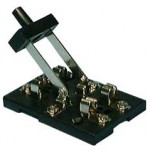 When you turn on a switch, it’s difficult to really see what’s going on… which is why we make our own from paperclips, brass fasteners, and index cards.
When you turn on a switch, it’s difficult to really see what’s going on… which is why we make our own from paperclips, brass fasteners, and index cards.
Kids can see the circuit on both sides of the card, so it makes sense why it works (especially after doing ‘Conductivity Testers’).
SPST stands for Single Pole, Single Throw, which means that the switch turns on only one circuit at a time. This is a great switch for one of the robots we’ll be making soon, as it only needs one motor to turn on and off.
Please login or register to read the rest of this content.
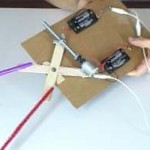 Are cookies out of reach in your house? When I was a small kid, the top of the refrigerator seemed MILES away… until I built a robot arm out of toothbrushes, popsicle sticks, and cardboard to reach it for me!
Are cookies out of reach in your house? When I was a small kid, the top of the refrigerator seemed MILES away… until I built a robot arm out of toothbrushes, popsicle sticks, and cardboard to reach it for me!
I’ve upgraded my old idea to include a motorized linear actuator so you can see how real robot engineers create linear motion (back and forth along a straight line) from a spinning motor. The motor AND nut both need to pivot for the claw to work, so take special note as to how the linear actuator (the scissors-looking thing) is built.
Imagine you have two magnets. Glue one magnet on an imaginary record player (or a ‘lazy susan’ turntable) and hold the other magnet in your hand. What happens when you bring your hand close to the turntable magnet and bring the north sides together?
The magnet should repel and move, and since it’s on a turntable, it will circle out of the way. Now flip your hand over so you have the south facing the turntable. Notice how the turntable magnet is attracted to yours and rotates toward your hand. Just as it reaches your hand, flip it again to reveal the north side. Now the glued turntable magnet pushes away into another circle as you flip your magnet over again to attract it back to you. Imagine if you could time this well enough to get the turntable magnet to make a complete circle over and over again… that’s how a motor works!
After you get the buzzer and the light or LED to work, try spinning a DC motor:
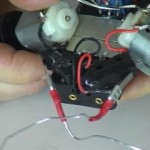 This project is advanced students. If you like tiny robots, then this one is for you! Powered by cheap hobby motors, this fast little robot zips ’round and avoids obstacles using momentary switches and an idler wheel for a tail.
This project is advanced students. If you like tiny robots, then this one is for you! Powered by cheap hobby motors, this fast little robot zips ’round and avoids obstacles using momentary switches and an idler wheel for a tail.
I recommend watching the entire video first, then rewind and watch again, this time building as you go. Make sure you have all your parts laid out ahead of time, or you’ll get frustrated partway through if you have to stop. You will need a soldering iron to make this project.
Here’s what you do:
Please login or register to read the rest of this content.
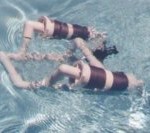 This project is for advanced students.
This project is for advanced students.
Up until 200 years ago, people thought the oceans were bottomless. The diving bell was one of the first recorded attempts at undersea exploration, and was simply a five-foot inverted cup with viewing holes on a platform that lowered into the water, which allowed people to breathe the trapped air inside… until they ran out of air. Leonardo da Vinci draw several sketches of underwater submersibles, and in the 1700s, John Lethbridge invented a long wooden cylinder with glass ends as one of the first diving units to reach 60 feet.
In 1930, two explorers used the bathysphere (a giant ball with windows) reached 1,428 feet below the surface, which was later followed by the bathyscape (deep diving vessel) that reached the deepest part of the Pacific Ocean, the Marianas Trench, at 35,800 feet in 1960.
The ROVs first made their appearance in the late 1960s, when military and offshore drilling required deeper dives. In the late 1980s, scientists needed a way to explore the remains of the Titanic, and a lower-cost, lighter weight version design was developed. ROVs are designed to be remote extensions of the operator.
One of the biggest challenges with deep-diving underwater vessels is keeping the tremendous pressure from crumpling the frame. The project we’re going to design is meant for swimming pools and smaller lakes. When designing your underwater vehicle, you’ll need to pay close attention to the finer details such as waterproofing the electrical motors and maintaining proper balance so that your robot doesn’t flip over or swim in circles.
Learn about thruster motors, create the chassis, and build the controller for these super-popular underwater robots that really swim in water! A fantastic project for parents and kids to work together on. Your underwater robot will move in all six directions and utilizes a 12V power source.
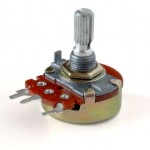 So now you know how to hook up a motor, and even wire it up to a switch so that it goes in forward and reverse. But what if you want to change speeds? This nifty electrical component will help you do just that.
So now you know how to hook up a motor, and even wire it up to a switch so that it goes in forward and reverse. But what if you want to change speeds? This nifty electrical component will help you do just that.
Once you understand how to use this potentiometer in a circuit, you’ll be able to control the speed of your laser light show motors as well as the motors and lights on your robots. Ready?
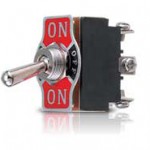 Once you’ve made a a simple switch, you’re ready to use more advanced electrical components, such as the DPDT switch you picked up from an electronics store (refer to shopping list for this section). When you wire up this nifty device, you’ll be able to get your motors to go forward, reverse, and stop… all with the flip of a switch.
Once you’ve made a a simple switch, you’re ready to use more advanced electrical components, such as the DPDT switch you picked up from an electronics store (refer to shopping list for this section). When you wire up this nifty device, you’ll be able to get your motors to go forward, reverse, and stop… all with the flip of a switch.
You can use this component along with a potentiometer so you can not only control the direction but also the speed of a motor, like in a robot or laser light show. And don’t feel limited on using this switch just with motors – it works with bi-polar LEDs and other things as well. For example, you can hook this up so that when it’s in the UP position, the buzzer sounds, and the DOWN position makes the headlights go on. Are you ready to learn how to wire this one up?
You can use the idea that like charges repel (like two electrons) and opposites attract to move stuff around, stick to walls, float, spin, and roll. Make sure you do this experiment first.
I’ve got two different videos that use positive and negative charges to make things rotate, the first of which is more of a demonstration (unless you happen to have a 50,000 Volt electrostatic generator on hand), and the second is a homemade version on a smaller scale.
Did you know that you can make a motor turn using static electricity? Here’s how:
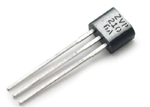 This simple FET circuit is really an electronic version of the electroscope. This “Alien Detector” is a super-sensitive static charge detector made from a few electronics parts. I originally made a few of these and placed them in soap boxes and nailed the lids shut and asked kids how they worked. (I did place a on/off switch poking through the box along with the LED so they would have ‘some’ control over the experiment.)
This simple FET circuit is really an electronic version of the electroscope. This “Alien Detector” is a super-sensitive static charge detector made from a few electronics parts. I originally made a few of these and placed them in soap boxes and nailed the lids shut and asked kids how they worked. (I did place a on/off switch poking through the box along with the LED so they would have ‘some’ control over the experiment.)
This detector is so sensitive that you can go around your house and find pockets of static charge… even from your own footprints! This is an advanced project for advanced students.
You will need to get:
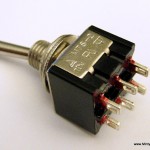 Radio control (RC) is a 100 year-old technology. RC requires both a transmitter and a receiver. The control box sends commands to the robot the same way you change channels on the TV with the remote.
Radio control (RC) is a 100 year-old technology. RC requires both a transmitter and a receiver. The control box sends commands to the robot the same way you change channels on the TV with the remote.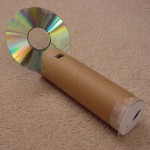 Spectrometers are used in chemistry and astronomy to measure light. In astronomy, we can find out about distant stars without ever traveling to them, because we can split the incoming light from the stars into their colors (or energies) and “read” what they are made up of (what gases they are burning) and thus determine their what they are made of. In this experiment, you’ll make a simple cardboard spectrometer that will be able to detect all kinds of interesting things!
Spectrometers are used in chemistry and astronomy to measure light. In astronomy, we can find out about distant stars without ever traveling to them, because we can split the incoming light from the stars into their colors (or energies) and “read” what they are made up of (what gases they are burning) and thus determine their what they are made of. In this experiment, you’ll make a simple cardboard spectrometer that will be able to detect all kinds of interesting things!
SPECIAL NOTE: This instrument is NOT for looking at the sun. Do NOT look directly at the sun. But you can point the tube at a sheet of paper that has the sun’s reflected light on it.
Usually you need a specialized piece of material called a diffraction grating to make this instrument work, but instead of buying a fancy one, why not use one from around your house? Diffraction gratings are found in insect (including butterfly) wings, bird feathers, and plant leaves. While I don’t recommend using living things for this experiment, I do suggest using an old CD.
CDs are like a mirror with circular tracks that are very close together. The light is spread into a spectrum when it hits the tracks, and each color bends a little more than the last. To see the rainbow spectrum, you’ve got to adjust the CD and the position of your eye so the angles line up correctly (actually, the angles are perpendicular).
You’re looking for a spectrum (the rainbow image at left) – this is what you’ll see right on the CD itself. Depending on what you look at (neon signs, chandeliers, incandescent bulbs, fluorescent bulbs, Christmas lights…), you’ll see different colors of the rainbow. For more about how diffraction gratings work, click here.
Materials:
Did you know that the word LASER stands for Light Amplification by Stimulated Emission of Radiation? And that a MASER is a laser beam with wavelengths in the microwave part of the spectrum? Most lasers fire a monochromatic (one color) narrow, focused beam of light, but more complex lasers emit a broad range of wavelengths at the same time.
In 1917, Einstein figured out the basic principles for the LASER and MASER by building on Max Planck’s work on light. It wasn’t until 1960, though when the first laser actually emitted light at Hughes Research Lab. Today, there are several different kinds of lasers, including gas lasers, chemical lasers, semiconductor lasers, and solid state lasers. One of the most powerful lasers ever conceived are gamma ray lasers (which can replace hundreds of lasers with only one) and the space-based x-ray lasers (which use the energy from a nuclear explosion) – neither of these have been built yet!
By using lenses and mirrors, you can bounce, shift, reflect, shatter, and split a laser beam. Since the laser beam is so narrow and focused, you’ll be able to see several reflections before it fades away from scatter. Make sure you complete the Laser Basics experiment first before working with this experiment.
You’ll need to make your beam visible for this experiment to really work. There are several different ways you can do this:
Lasers are cool, but what can you do with one? This is a great introductory activity into what lasers are, how they work, and how different mediums (like glass, feathers, mirrors, etc.) can change the direction of the beam.
Lasers are a monochromatic (one color) concentrated beam of light. This means that when compared with a flashlight, the laser delivers more punch on a light detector. The alignment is more critical (as you’ll find out when you zig-zag a laser through several mirrors), so take your time and do these experiments in a steamy, dark bathroom after a hot shower. That way, you’ll be able to see the beam and align your optics easily.
Please login or register to read the rest of this content.
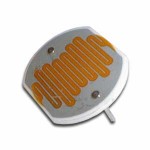 This is a super-cool and ultra-simple circuit experiment that shows you how a CdS (cadmium sulfide cell) works. A CdS cell is a special kind of resistor called a photoresistor, which is sensitive to light.
This is a super-cool and ultra-simple circuit experiment that shows you how a CdS (cadmium sulfide cell) works. A CdS cell is a special kind of resistor called a photoresistor, which is sensitive to light.
A resistor limits the amount of current (electricity) that flows through it, and since this one is light-sensitive, it will allow different amounts of current through depends on how much light it "sees".
Photoresistors are very inexpensive light detectors, and you'll find them in cameras, street lights, clock radios, robotics, and more. We're going to play with one and find out how to detect light using a simple series circuit.
Materials:
 This is a super-cool and ultra-simple circuit experiment that shows you how a CdS (cadmium sulfide cell) works. A CdS cell is a special kind of resistor called a photoresistor, which is sensitive to light.
This is a super-cool and ultra-simple circuit experiment that shows you how a CdS (cadmium sulfide cell) works. A CdS cell is a special kind of resistor called a photoresistor, which is sensitive to light.
A resistor limits the amount of current (electricity) that flows through it, and since this one is light-sensitive, it will allow different amounts of current through depends on how much light it "sees".
Photoresistors are very inexpensive light detectors, and you'll find them in cameras, street lights, clock radios, robotics, and more. We're going to play with one and find out how to detect light using a simple series circuit.
Materials:
This is a beefier-version of the Electric Eye that will be able to turn on a buzzer instead of a LED by increasing the voltage in the circuit. This type of circuit is a light-actuated circuit. When a beam of light hits the sensor (the “eye”), a buzzer sounds. Use this to indicate when a door closes or drawer closes… your suspect will never know what got triggered.
Please login or register to read the rest of this content.
If you’ve already made the Laser Burglar Alarm (which is highly recommend doing FIRST), then you’re probably wondering how to make the circuit act in the opposite way… meaning how do you make it so that the buzzer sounds when the light is turned off?
This circuit requires more patience and parts, but it’s totally worth it. It uses the same parts as the previous experiment (plus a few more) with a couple of extra twists and turns in the circuit to let the buzzer know when it’s time to turn off. Use this in doorways or as an invisible trip wire trigger across hallways.
Materials:
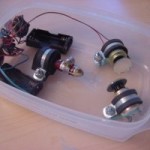 What happens when you shine a laser beam onto a spinning mirror? In the Laser Maze experiment, the mirrors stayed put. What happens if you took one of those mirrors and moved it really fast?
What happens when you shine a laser beam onto a spinning mirror? In the Laser Maze experiment, the mirrors stayed put. What happens if you took one of those mirrors and moved it really fast?
It turns out that a slightly off-set spinning mirror will make the laser dot on the wall spin in a circle. Or ellipse. Or oval. And the more mirrors you add, the more spiro-graph-looking your projected laser dot gets.
Why does it work? This experiment works because of imperfections: the mirrors are mounted off-center, the motors wobble, the shafts do not spin true, and a hundred other reasons why our mechanics and optics are not dead-on straight. And that’s exactly what we want – the wobbling mirrors and shaky motors make the pretty pictures on the wall! If everything were absolutely perfectly aligned, all you would see is a dot.
Here’s how to do this experiment:
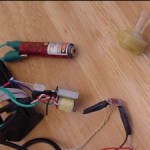 This experiment is for advanced students.Did you know that when you talk inside a house, the windows vibrate very slightly from your voice? If you stand outside the house and aim a laser beam at the window, you can pick up the vibrations in the window and actually hear the conversation inside the house.
This experiment is for advanced students.Did you know that when you talk inside a house, the windows vibrate very slightly from your voice? If you stand outside the house and aim a laser beam at the window, you can pick up the vibrations in the window and actually hear the conversation inside the house.
Remember how windows split a laser beam in two from the Laser Basics experiment? That’s the basic idea behind it. First, I’ll show you how to build your own space-age laser communicator, then you can work on your spy device.
The first thing we’re going to do is take the music from your stereo or MP3 player and transmit it on a laser beam to a detector on the other side. The detector has an earphone attached, so someone else can listen to the music from your laser. Weird, huh?
Here’s how to build your own:
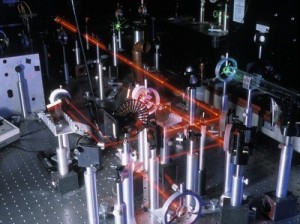 This super-cool project lets kids have the fun of playing tag in the dark on a warm summer evening, without the "gun" aspect traditionally found in laser tag. Kids not only get to enjoy the sport but also have the pride that they build the tag system themselves - something you simply can't get from opening up a laser tag game box.
This super-cool project lets kids have the fun of playing tag in the dark on a warm summer evening, without the "gun" aspect traditionally found in laser tag. Kids not only get to enjoy the sport but also have the pride that they build the tag system themselves - something you simply can't get from opening up a laser tag game box.
While real laser tag games actually never use lasers, but rather infrared beams, this laser tag uses real lasers, so you'll want to arm the kids with the "no-lasers-on-the-face" with a 10-minute time-out penalty to ensure everyone has a good time. You can alternatively use flashlights instead of lasers, which makes the game a lot easier to tag someone out.
This game uses a simple two-transistor latching circuit design, so there's no programming or overly complicated circuitry to worry about. If you've never built this kind of circuit before, it's a perfect first step into the world of electronics.
I've provided you with three videos below. This first video is an introduction to what we are going to make and how it works. Here's what you need:
NOTE: We updated this circuit in 2023 to reflect "best practices" when using transistors.
Be sure to build this project as shown in the schematic and breadboard diagrams, and not as shown in the video.
The material list below is based on the new design as shown in the schematic and breadboard diagrams on this page.
The videos show how to build the old circuit, but are still very useful.
Wouldn’t it be nice to wake up your brother or sister using an alarm you build yourself, triggered by natural sunlight? The happy news is now you can, using your Flashlight Laser Tag circuit you already built!
Since your circuit is already sensitive to light, you can transform it easily into an alarm clock that will buzz or light up when hit by the sun’s rays.
Note – you can also use your Laser Door Alarm for this as well, since it’s also triggered by light. However, the Burglar Alarm will not work, because it gets triggered by darkness, so unless you want your alarm to sound just as your drifting off to sleep, you’ll want to use the Laser Door Alarm or the Flashlight Laser Tag circuit. Here’s what you need to know (it’s really simple…):
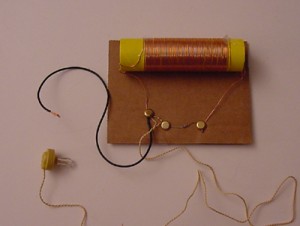 In addition to laser experiments, I thought you’d like to learn how to pick up sound that’s traveling on a light wave. A crystal radio is among the simplest of radio receivers – there’s no battery or power source, and nearly no moving parts. The source of power comes directly from the radio waves (which is a low-power, low frequency light wave) themselves.
In addition to laser experiments, I thought you’d like to learn how to pick up sound that’s traveling on a light wave. A crystal radio is among the simplest of radio receivers – there’s no battery or power source, and nearly no moving parts. The source of power comes directly from the radio waves (which is a low-power, low frequency light wave) themselves.
The crystal radio turns the radio signal directly into a signal that the human ear can detect. Your crystal radio detects in the AM band that have been traveling from stations (transmitters) thousands of miles away. You’ve got all the basics for picking up AM radio stations using simple equipment from an electronics store. I’ll show you how…
The radio is made up of a tuning coil (magnet wire wrapped around a toilet paper tube), a detector (germanium diode) and crystal earphones, and an antenna wire.
One of the biggest challenges with detecting low-power radio waves is that there is no amplifier on the radio to boost the signal strength. You’ll soon figure out that you need to find the quietest spot in your house away from any transmitters (and loud noises) that might interfere with the reception when you build one of these.
One of things you’ll have is to figure out the best antenna length to produce the clearest, strongest radio signal in your crystal radio. I’m going to walk you through making three different crystal radio designs.
You’ll need to find these items below.
Here’s what you do:
An average can of soda at room temperature measures 55 psi before you ever crack it open. (In comparison, most car tires run on 35 psi, so that gives you an idea how much pressure there is inside the can!)
If you heat a can of soda, you’ll run the pressure over 80 psi before the can ruptures, soaking the interior of your house with its sugary contents. Still, you will have learned something worthwhile: adding energy (heat) to a system (can of soda) causes a pressure increase. It also causes a volume increase (kaboom!).
How about trying a safer variation of this experiment using water, an open can, and implosion instead of explosion?
Materials – An empty soda can, water, a pan, a bowl, tongs, and a grown-up assistant.
NOTE: If you can get a hold of one, use a beer can – they tend to work better for this experiment. But you can also do this with a regular old soda can. And no, I am not suggesting that kids should be drinking alcohol! Go ask a parent to find you one – and check the recycling bin.
This is one of those 'chemistry magic show' type of experiments to wow your friends and family. Here's the scoop: you take a cup of clear liquid, add it to another cup of clear liquid, stir for ten seconds, and you'll see a color change, a state change from liquid to solid, and you can pull a rubber-like bouncy ball right out of the cup.
When you think of slime, do you imagine slugs, snails, and puppy kisses? Or does the science fiction film The Blob come to mind? Any way you picture it, slime is definitely slippery, slithery, and just plain icky — and a perfect forum for learning real science.
But which ingredients work in making a truly slimy concoction, and why do they work? Let’s take a closer look…
Imagine a plate of spaghetti. The noodles slide around and don’t clump together, just like the long chains of molecules (called polymers) that make up slime. They slide around without getting tangled up. The pasta by itself (fresh from the boiling water) doesn’t hold together until you put the sauce on. Slime works the same way. Long, spaghetti-like chains of molecules don’t clump together until you add the sauce … until you add something to cross-link the molecule strands together.
The sodium-tetraborate-and-water mixture is the “spaghetti” (the long chain of molecules, also known as a polymer), and the “sauce” is the glue-water mixture (the cross-linking agent). You need both in order to create a slime worthy of Hollywood filmmakers.
What state of matter is fire? Is it a liquid? I get that question a LOT, so let me clarify. The ancient scientists (Greek, Chinese… you name it) thought fire was a fundamental element. Earth, Air Water, and Fire (sometimes Space was added, and the Chinese actually omitted Air and substituted Wood and Metal instead) were thought to be the basic building blocks of everything, and named it an element. And it’s not a bad start, especially if you don’t have a microscope or access to the internet.
Today’s definition of an element comes from peeking inside the nucleus of an atom and counting up the protons. In a flame, there are lots of different molecules from NO, NO2, NO3, CO, CO2, O2, C… to name a few. So fire can’t be an element, because it’s made up of other elements. So, what is it?
If you had a choice between a glass of lemon juice or apple juice, most folks would pick the sweeter one – apple. Did you know that apples are loaded with malic acid, and are actually considered to be acidic? It’s just that there is so much more sugar in an apple than a lemon that your taste buds can be fooled. Here’s a scientific way (which is much more reliable) to tell how acidic something is.
Acids are sour tasting (like a lemon), bases are bitter (like unsweetened cocoa powder). Substances in the middle are more neutral, like water. Scientists use the pH (power of hydrogen, or potential hydrogen) scale to measure how acidic or basic something is. Hydrochloric acid registers at a 1, sodium hydroxide (drain cleaner) is a 14. Water is about a 7. pH levels tell you how acidic or alkaline (basic) something is, like dirt. If your soil is too acidic, your plants won’t attract enough hydrogen, and too alkaline attracts too many hydrogen ions. The right balance is usually somewhere in the middle (called ‘pH neutral’). Some plants change color depending on the level of acidity in the soil – hydrangeas turn pink in acidic soil and blue in alkaline soil.
There are many different kinds of acids: citric acid (in a lemon), tartaric acid (in white wine), malic acid (in apples), acetic acid (in vinegar), and phosphoric acid (in cola drinks). The battery acid in your car is a particularly nasty acid called sulfuric acid that will eat through your skin and bones. Hydrochloric acid is found in your stomach to help digest food, and nitric acid is used to make dyes in fabrics as well as fertilizer compounds.
This is the experiment that your audience will remember from your chemistry magic show. Here’s what happens – you call up six ‘helpers’ and hand each a seemingly empty test tube. Into each test tube, pour a little of the main gold-colored solution, say a few magic words, and their test tubes turn clear, black, pink, gold, yellow, and white. With a flourish, ask them to all pour their solutions back into yours and the final solution turns from inky black to clear. Voila!
I first saw a similar experiment when I was a kid, and I remembered it all the way through college, where I asked my professor how I could duplicate the experiment on my own. I was told that the chemicals used in that particular experiment were way too dangerous, and no substitute experiment was possible, especially for the color reversal at the end. I was determined to figure out an alternative. After two weeks of nothing but chemistry and experiment testing, I finally nailed it – and the best part is, you have most of these chemicals at the grocery store. (And the best part is, I can share it with you as I’ve eliminated the nasty chemicals so you don’t have to worry about losing an eyeball or a finger.)
NOTE: This experiment requires adult help, as it uses chemicals that are toxic if randomly mixed together. Follow the instructions carefully, and do not mix random chemicals together.
Are you ready to mix up your own rainbow?
Hydrogen peroxide is used to fuel rockets, airplanes, and other vehicle engines. Chemistry teachers everywhere use it to demonstrate the power of a catalyst.
To speed up a reaction without altering the chemistry of the reaction involves adding a catalyst. A catalyst changes the rate of reaction but doesn’t get involved in the overall chemical changes.
For example, leaving a bottle of hydrogen peroxide outside in the sunlight will cause the hydrogen peroxide to decompose. However, this process takes a long time, and if you don’t want to wait, you can simply toss in a lump of charcoal to speed things along.
The carbon is a catalyst in the reaction, and the overall effect is that instead of taking two months to generate a balloon full of oxygen, it now only takes five minutes. The amount of charcoal you have at the end of the reaction is exactly the same as before it started.
A catalyst can also slow down a reaction. A catalytic promoter increases the activity, and a catalytic poison (also known as a negative catalyst, or inhibitor) decreases the activity of a reaction. Catalysts offer a different way for the reactants to become products, and sometimes this means the catalyst reacts during the chemical reaction to form intermediates. Since the catalyst is completely regenerated before the reaction is finished, it’s considered ‘not used’ in the overall reaction.
In this experiment, you’ll see that there’s a lot of oxygen hiding inside the peroxide – enough to really make things interesting and move around! You’ll also find out what happens to soap when you bubble oxygen through it. Are you ready?
This project is simple, yet highly satisfying. The current record distance traveled is 74 feet... can you beat that? Make sure you launch these UP, not horizontally! You only need three items, all of which are in your house right now! First, you need a piece of...
This project is simple, yet highly satisfying. The current record distance traveled is 74 feet... can you beat that? Make sure you launch these UP, not horizontally! You only need three items, all of which are in your house right now! First, you need a piece of...
Rockets shoot skyward with massive amounts of thrust, produced by chemical reaction or air pressure. Scientists create the thrust force by shoving a lot of gas (either air itself, or the gas left over from the combustion of a propellant) out small exit nozzles.
According to the universal laws of motion, for every action, there is equal and opposite reaction. If flames shoot out of the rocket downwards, the rocket itself will soar upwards. It’s the same thing if you blow up a balloon and let it go—the air inside the balloon goes to the left, and the balloon zips off to the right (at least, initially, until the balloon neck turns into a thrust-vectored nozzle, but don’t be concerned about that just now).
A rocket has a few parts different from an airplane. One of the main differences is the absence of wings. Rockets utilize fins, which help steer the rocket, while airplanes use wings to generate lift. Rocket fins are more like the rudder of an airplane than the wings.
Another difference is the how rockets get their speed. Airplanes generate thrust from a rotating blade, whereas rockets get their movement by squeezing down a high-energy gaseous flow and squeezing it out a tiny exit hole.
If you’ve ever used a garden hose, you already know how to make the water stream out faster by placing your thumb over the end of the hose. You’re decreasing the amount of area the water has to exit the hose, but there’s still the same amount of water flowing out, so the water compensates by increasing its velocity. This is the secret to converging rocket nozzles—squeeze the flow down and out a small exit hole to increase velocity.
There comes a point, however, when you can’t get any more speed out of the gas, no matter how much you squeeze it down. This is called “choking” the flow. When you get to this point, the gas is traveling at the speed of sound (around 700 mph, or Mach 1). Scientists found that if they gradually un-squeeze the flow in this choked state, the flow speed actually continues to increase. This is how we get rockets to move at supersonic speeds or above Mach 1.
 The image shown here is a real picture of an aircraft as it breaks the sound barrier. This aircraft is passing the speed at which sounds travel. The white cloud you see in the photo is related to the shock waves that are forming around the craft as it moves into supersonic speeds. Because the aircraft is moving through air, which is a gas, the gas can compress and results in a shock wave.
The image shown here is a real picture of an aircraft as it breaks the sound barrier. This aircraft is passing the speed at which sounds travel. The white cloud you see in the photo is related to the shock waves that are forming around the craft as it moves into supersonic speeds. Because the aircraft is moving through air, which is a gas, the gas can compress and results in a shock wave.
You can think of a shock wave as big pressure front. In this photo, the pressure is condensing water vapor in the air, hence the cloud. There are lots of things on earth that break the sound barrier – bullets and bullwhips, for example. The loud crack from a whip is the tip zipping faster than the speed of sound.
The rockets we're about to build get their thrust by generating enough pressure and releasing that pressure very quickly. You will generate pressure both by pumping and by chemical reaction, which generates gaseous products. Let's get started!
For this experiment, you will need:
These are a set of videos made using planetarium software to help you see how the stars and planets move over the course of months and years. See what you think and tell us what you learned by writing your comments in the box below.
You can really feel the Earth rolling around under you as you watch these crazy star trails.
Please login or register to read the rest of this content.
Ever wonder exactly how far away the planets really are? Here’s the reason they usually don’t how the planets and their orbits to scale – they would need a sheet of paper nearly a mile long!
To really get the hang of how big and far away celestial objects really are, find a long stretch of road that you can mark off with chalk. We’ve provided approximate (average) orbital distances and sizes for building your own scale model of the solar system.
When building this model, start by marking off the location of the sun (you can use chalk or place the objects we have suggested below as placeholders for the locations). Are you ready to find out what’s out there? Then let’s get started.
Materials:
Please login or register to read the rest of this content.
Please login or register to read the rest of this content.
After you've participated in the Planetarium Star Show (either live or by listening to the MP3 download), treat your kids to a Solar System Treasure Hunt! You'll need some sort of treasure (I recommend astronomy books or a pair of my favorite binoculars, but you can also use 'Mars' candy bars or home made chocolate chip cookies (call them Galaxy Clusters) instead.
You can print out the clues and hide these around your house on a rainy day. Did you know that I made these clues up myself as a refresher course after the astronomy presentation? Enjoy!
You know you're not supposed to look at the sun, so how can you study it safely? I'm going to show you how to observe the sun safely using a very inexpensive filter. I actually keep one of these in the glove box of my car so I can keep track of certain interesting sunspots during the week!
The visible surface of the sun is called the photosphere, and is made mostly of plasma (remember the grape experiment?) that bubbles up hot and cold regions of gas. When an area cools down, it becomes darker (called sunspots). Solar flares (massive explosions on the surface), sunspots, and loops are all related the sun’s magnetic field. While scientists are still trying to figure this stuff out, here’s the latest of what they do know...
The sun is a large ball of really hot gas - which means there are lots of naked charged particles zipping around. And the sun also rotates, but the poles and the equator move and different speeds (don’t forget – it’s not a solid ball but more like a cloud of gas). When charged particles move, they make magnetic fields (that’s one of the basic laws of physics). And the different rotation rates allow the magnetic fields to ‘wind up’ and cause massive magnetic loops to eject from the surface, growing stronger and stronger until they wind up flipping the north and south poles of the sun (called ‘solar maximum’). The poles flip every eleven years.
There have been several satellites specially created to observe the sun, including Ulysses (launched 1990, studied solar wind and magnetic fields at the poles), Yohkoh (1991-2001, studied x-rays and gamma radiation from solar flares), SOHO (launched 1995, studies interior and surface), and TRACE (launched 1998, studies the corona and magnetic field).
Ok - so back to observing the sun form your own house. Here's what you need to do:
The Hubble Space Telescope (HST) zooms around the Earth once every 90 minutes (about 5 miles per second), and in August 2008, Hubble completed 100,000 orbits! Although the HST was not the first space telescope, is the one of the largest and most publicized scientific instrument around. Hubble is a collaboration project between NASA and the ESA (European Space Agency), and is one of NASA’s “Great Observatories” (others include Compton Gamma Ray Observatory, Chandra X-Ray Observatory, and Spitzer Space Telescope). Anyone can apply for time on the telescope (you do not need to be affiliated with any academic institution or company), but it’s a tight squeeze to get on the schedule.
Hubble’s orbit zooms high in the upper atmosphere to steer clear of the obscuring haze of molecules in the sea of air. Hubble’s orbit slowly decays over time and begins to spiral back into Earth until the astronauts bump it back up into a higher orbit.
But how does a satellite stay in orbit? Try this experiment now:
Materials:
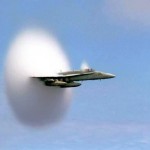 Sound can change according to the speed at which it travels. Another word for sound speed is pitch. When the sound speed slows, the pitch lowers. With clarinet reeds, it’s high. Guitar strings can do both, as they are adjustable. If you look carefully, you can actually see the low pitch strings vibrate back and forth, but the high pitch strings move so quickly it’s hard to see. But you can detect the effects of both with your ears.
Sound can change according to the speed at which it travels. Another word for sound speed is pitch. When the sound speed slows, the pitch lowers. With clarinet reeds, it’s high. Guitar strings can do both, as they are adjustable. If you look carefully, you can actually see the low pitch strings vibrate back and forth, but the high pitch strings move so quickly it’s hard to see. But you can detect the effects of both with your ears.
This is one of my absolute favorites, because it’s so unexpected and unusual… the setup looks quite harmless, but it makes a sound worse than scratching your nails on a chalkboard. If you can’t find the weird ingredient, just use water and you’ll get nearly the same result (it just takes more practice to get it right). Ready?
NOTE: DO NOT place these anywhere near your ear… keep them straight out in front of you.
You can easily make a humming (or screaming!) balloon by inserting a small hexnut into a balloon and inflating. You can also try pennies, washers, and anything else you have that is small and semi-round. We have scads of these things at birthday time, hiding small change in some and nuts in the others so the kids pop them to get their treasures. Some kids will figure out a way to test which balloons are which without popping… which is what we’re going to do right now.
Before CDs, there were these big black discs called records. Spinning between 33 and 45 times per minute on a turntable, people used to listened to music just like this for nearly a century. Edison, who had trouble hearing, used to bite down hard on the side of his wooden record player (called a phonograph) and “hear” the music as it vibrated his jaw.
Many people today still think that records still sound better than CDs (I think they do), especially if the record is well cared for and their players are tuned just right. Here’s a video on how a record works:
This experiment is for Advanced Students.There are several different ways of throwing objects. This is the only potato cannon we’ve found that does NOT use explosives, so you can be assured your kid will still have their face attached at the end of the day. (We’ll do more when we get to chemistry, so don’t worry!)
These nifty devices give off a satisfying *POP!!* when they fire and your backyard will look like an invasion of aliens from the French Fry planet when you’re done. Have your kids use a set of goggles and do all your experimenting outside.
Here’s what you need:
Bobsleds use the low-friction surface of ice to coast downhill at ridiculous speeds. You start at the top of a high hill (with loads of potential energy) then slide down a icy hill til you transform all that potential energy into kinetic energy. It’s one of the most efficient ways of energy transformation on planet Earth. Ready to give it a try?
This is one of those quick-yet-highly-satisfying activities which utilizes ordinary materials and turns it into something highly unusual… for example, taking aluminum foil and marbles and making it into a racecar.
While you can make a tube out of gift wrap tubes, it’s much more fun to use clear plastic tubes (such as the ones that protect the long overhead fluorescent lights). Find the longest ones you can at your local hardware store. In a pinch, you can slit the gift wrap tubes in half lengthwise and tape either the lengths together for a longer run or side-by-side for multiple tracks for races. (Poke a skewer through the rolls horizontally to make a quick-release gate.)
Here’s what you need:
A rocket has a few parts different from an airplane. One of the main differences is the absence of wings. Rockets utilize fins, which help steer the rocket, while airplanes use wings to generate lift. Rocket fins are more like the rudder of an airplane than the wings. A fighter plane is like a cross between a rocket and an airplane, because of the high amount of thrust generated by the engines.
A pulse jet engine is something students make in college engineering courses under the direction of experienced professors. When I was a student, we made a small Pulse Jet Engine out of clear acrylic that burned bright and loud enough to wear eye and hearing protection.
These types of engines are very simple, as they have no moving parts. They've been used on scram jet engines and other types of supersonic craft. A pulsejet engine works by alternately pushing out a hot breath of air rearward and then breathing in fresh air to replace it. They can run on gasoline, diesel, or kerosene.
The video below is for DEMONSTRATION PURPOSES ONLY. Please read text below the video.
 This experiment is for Advanced Students. For ages, people have been hurling rocks, sticks, and other objects through the air. The trebuchet came around during the Middle Ages as a way to break through the massive defenses of castles and cities. It’s basically a gigantic sling that uses a lever arm to quickly speed up the rocks before letting go. A trebuchet is typically more accurate than a catapult, and won’t knock your kid’s teeth out while they try to load it.
This experiment is for Advanced Students. For ages, people have been hurling rocks, sticks, and other objects through the air. The trebuchet came around during the Middle Ages as a way to break through the massive defenses of castles and cities. It’s basically a gigantic sling that uses a lever arm to quickly speed up the rocks before letting go. A trebuchet is typically more accurate than a catapult, and won’t knock your kid’s teeth out while they try to load it.
Trebuchets are really levers in action. You’ll find a fulcrum carefully positioned so that a small motion near the weight transforms into a huge swinging motion near the sling. Some mis-named trebuchets are really ‘torsion engines’, and you can tell the difference because the torsion engine uses the energy stored in twisted rope or twine (or animal sinew) to launch objects, whereas true trebuchets use heavy counterweights.
Ever wonder how magicians work their magic? This experiment is worthy of the stage with a little bit of practice on your end.
Here’s how this activity is laid out: First, watch the video below. Next, try it on your own. Make sure to send us your photos of your inventions here!
We’re going to experiment with Newton’s Third law by blowing up balloons and letting them rocket, race, and zoom all over the place. When you first blow up a balloon, you’re pressurizing the inside of the balloon by adding more air (from your lungs) into the balloon. Because the balloon is made of stretchy rubber (like a rubber band), the balloon wants to snap back into the smallest shape possible as soon as it gets the chance (which usually happens when the air escapes through the nozzle area). And you know what happens next – the air inside the balloon flows in one direction while the balloon zips off in the other.
Question: why does the balloon race all over the room? The answer is because of something called ‘thrust vectoring’, which means you can change the course of the balloon by angling the nozzle around. Think of the kick you’d feel if you tried to angle around a fire hose operating at full blast. That kick is what propels balloons and fighter aircraft into their aerobatic tricks.
We’re going to perform several experiments here, each time watching what’s happening so you get the feel for the Third Law. You will need to find:
First, let’s experiment with the balloon. Here’s what you can do:
This is a satisfyingly simple activity with surprising results. Take a tennis ball and place it on top of a basketball… then release both at the same time.
Instant ball launcher!
You’ll find the top ball rockets off skyward while the lower ball hit the floor flat (without bouncing much, if at all). Now why is that? It’s easier to explain than you think…
Remember momentum? Momentum can be defined as inertia in motion. Something must be moving to have momentum. Momentum is how hard it is to get something to stop or to change directions. A moving train has a whole lot of momentum. A moving ping pong ball does not. You can easily stop a ping pong ball, even at high speeds. It is difficult, however, to stop a train even at low speeds.
Mathematically, momentum is mass times velocity, or Momentum=mv.
One of the basic laws of the universe is the conservation of momentum. When objects smack into each other, the momentum that both objects have after the collision, is equal to the amount of momentum the objects had before the crash. Once the two balls hit the ground, all the larger ball’s momentum transferred to the smaller ball (plus the smaller ball had its own momentum, too!) and thus the smaller ball goes zooming to the sky.
Materials:
 Building the perfect robot for the right job.
Building the perfect robot for the right job.Even if you think you’ve outgrown LEGOs, take a second look at the inventions below that I’ve created. Many scientists and engineers got their start building with LEGOs! My kids and I share many LEGO sets together, and my absolute favorite is the 1999 Lego Mindstorms set.
We still use it to build and program robots today! But don’t feel limited to this set, as it’s hard to find nowadays. Use this page as a source of inspiration for your own inventions. Although these are images and not videos, do you think you can still figure out how they move?
 Tabletop Cleaner
Tabletop CleanerA combination of the Ultimate Builder’s Set and my own creativeness and a differential light sensor (see below under “sensors”), this little guy can stay on a tabletop with right and left edge detectors, rear edge detector, and avoid obstacles with a left and right bump touch sensors, and can track a beam of light or find a light source using Michael Gasperi’s differential light detector. Using six sensors mulit-plexed into three available input ports on one RCX, a little creative programming, and three motors (one for the brushes, two for the drive) makes for a cool project!
this little guy can stay on a tabletop with right and left edge detectors, rear edge detector, and avoid obstacles with a left and right bump touch sensors, and can track a beam of light or find a light source using Michael Gasperi’s differential light detector. Using six sensors mulit-plexed into three available input ports on one RCX, a little creative programming, and three motors (one for the brushes, two for the drive) makes for a cool project!
 The Claw IV
The Claw IVOne of the first things I’ve built from the Mindstorms box: I added pneumatics and a ball, and suddenly I have a 4-axis grabber arm with a pneumatic claw that picks up balls from one location and deposits them to the target every single time! I must add that if it were strictly open-loop program, it would miss after the second or third try, as it never quite comes back to the same spot. This MEGA CLAW uses four sensors, five motors (three for the three-axis movement, one to operate the pneumatics valve, one as a pump to keep the air tank stocked), one RCX, and one Scout (to handle the extra motor ports). Sensors detect the mechanical limits of the arm.
I initially wanted to make a 5 or 6-axis arm, but decided to wait until I understood how to get these pieces to fit together more efficiently.
 Max the Hexapod
Max the Hexapod
I was so intrigued by the idea of a six-legged walker that I went right to the source – Flik by Nick Donaldson and Hexapod by JP Brown and made JP’s posted version of a single RCX Hexapod. It worked wonderfully! It took every last LEGO piece I owned to put Max together, as he’s a rather large robot – over 2 feet long, not including the whiskers.
 |
 |
| Aft Articulation Point | Forward Articulation Point |

This is a Killough drive system from Macs Robotics Page. This platform can simultaneously rotate while driving forward. Think of how an office chair’s wheel base rotates around while you push the chair across the
room.

Same assembly three times make up the structure of this amazing robot platform.


This is a Synchro motor drive system also inspired by Building Robots with LEGO Mindstorms by Mario Ferrari et al. The coolness behind this system is the robots ability to turn its wheels in place without
turning the platform – hence this robot does not have a “front”, “rear”, “left”, or “right” – it goes in all directions!

Wheel assembly – each wheel is powered and can change orientation.

Top view – note that this robot was built upside-down!!


Yet another Building Robots with LEGO Mindstorms inspired design. I did not have an RCX free when I built this, so I plugged it into the Scout and made both motors go forward. What was interesting about this was the vehicle initially went straight, then slowed and turned, then reversed direction in the turn, went backward, and began to turn again. One motor controls the drive, and the other controls the front wheel’s orientation. So when someone asks, “Can you build a car to go forward and reverse without reversing the motors?” you can say “Yes!”


This robot was inspired by Building Robots with LEGO Mindstorms by Mario Ferrari et al. The idea is to make a walker platform stable enough to turn tight corners while line-tracking. The only improvement I would do next time is to couple the motors (independent motors – one per side – in above photo) so it does not have a gradual turn while it walks!


From Jin Sato’s book, The Master’s Technique, we created MIBO, a LEGO version of SONY’s AIBO – a robotic dog that can sit, shake (sort of), and shuffle along the floor. He barks (more like a beep, really), and is lots of fun!!! We’re adding non-LEGO parts, such as a wireless camera and sound sensor for further abilities for MIBO. (Chasing ball and following a whistle?) We’re really excited about MIBO and thank Jin Sato for all his hard work!
|
|

 |
The SHRIMP is a high-mobility wheeled rover designed by the Autonomous Systems Lab in Lausanne, Switzerland. This innovative rover is capable of climbing over objects 2.5 times its wheel diameter!
 |
 |
 |
 |
 |
Whiz is a “whiz with sensors!” robot geared for a complex game of RoboTag. This amazing robot is capable of exploring and reacting to its environment! Whiz is loaded with a differential light sensor to seek and find
light, a sound sensor to detect and react to sharp sounds, a line-detecting sensor mounted on the front for staying on a tabletop or within a black-outlined rink, and it can avoid obstacles by knowing which bumper – front or back – is triggered.
 |

Differential Light Sensor
|

Sound Sensor
Due to port limitations, I’ve plugged in a relay to switch between the sound and differential light sensor. The following ports are connected:
| Input 1 | Touch Sensors (both) |
| Input 2 | LEGO Light Sensor |
| Input 3 | Differential Light Sensor and Sound Sensor |
| Out A | Left Motor |
| Out B | Relay and LEGO Lamps (optional) |
| Out C | Right Motor |

Front View(Two “eyeballs” are CdS light detectors in the differential light sensor) |

Rear View (see the microphone?) |

Top View (Blue box on left side is the relay) |

Right Profile (Rear -> Front)
|

Left Profile (Front -> Rear)
|
 |
 |
These sensors were adapted from Extreme Mindstorms: An Advanced Guide to Lego Mindstorms by Dave Baum, Michael Gasperi, Ralph Hempel and Luis Villa. Many thanks to all these wonderful inventors for their genius!
 |
This differential light sensor (as described in great detail in Michael Gasperi’s section of the book mentioned above) does a wonderful job of being a “smart sensor”. What would normally take 2 of your 3 sensor input ports to tell which way a light source is (to the left or right), this one tells you the difference and takes only 1 input port! You don’t need the full capacity of the LM324N – if you have a 358 handy, use it. The larger the CdS photocells, the better it reacts. This sensor is excellent for tracking a light source!! Currently used on Whiz. |
| A sound sensor initially seemed like a silly idea – especially when Michael Gasperi pointed out that it turned your expensive LEGO robot into a clapper. But then, during a game of RoboTag, we realized that it might not be such a bad idea. It would be handy to have one robot beep and the other listen and search for it. It worked pretty well for our application, and allowed us to use multiple robots to search for different characteristics (light, sound, touch, temperature…). Currently used on Whiz. |
 |
 |
I just had to know what was inside the expensive little light sensor that comes with the RIS. I was very excited when I found the schematic online and went to work right away. I am lucky enough to have a lot of parts on hand, and have noted some standard parts you can use if you don’t have the oddball ones mentioned in the schematic. Works great!! (Not currently used on Whiz) |
| I figured, if the sensor above can see light, why not add in IR capabilities and find out if it can see the difference between white and black? Take out the phototransistor (the transistor in the schematic without a base) and insert an IR detector. Add in the LED everyone’s always taking out – but be sure it’s an IR or visible red LED (red LEDs often also emit in the IR range, and you can see if they are on). If you wrap the detector in electrical tape to shield it from side-lighting from the LED, it works more accurately. It has a drop 15-20 (out of 100) between black and white, depending on your lighting conditions. Good enough for line-tracking! (Not currently used on Whiz) |
 |
 |
If you’re short on input ports, and you’ve got two touch sensors to wire to only one port, consider this: wouldn’t it be nice if the RCX read one value for one sensor, and a different value for the second sensor? To make one sensor read differently than another when both are plugged into the same input, you’ll need to make a special wire for the connection. Solder in a 22k resistor at the end of one of the wire leads just before it goes onto the electric plate, and your touch sensor will read about 50, whereas your straight connection (using the black wires that came with your RIS set for connecting sensors) will read 100. When you program, pretend it’s a light sensor reading two different values. Currently used on Whiz. |
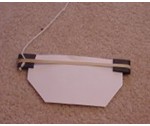 Sound is everywhere. It can travel through solids, liquids, and gases, but it does so at different speeds. It can rustle through trees at 770 MPH (miles per hour), echo through the ocean at 3,270 MPH, and resonate through solid rock at 8,600 MPH.
Sound is everywhere. It can travel through solids, liquids, and gases, but it does so at different speeds. It can rustle through trees at 770 MPH (miles per hour), echo through the ocean at 3,270 MPH, and resonate through solid rock at 8,600 MPH.
Sound is made by things vibrating back and forth, whether it’s a guitar string, drum head, or clarinet. The back and forth motion of an object (like the drum head) creates a sound wave in the air that looks a lot like a ripple in a pond after you throw a rock in. It radiates outward, vibrating it’s neighboring air molecules until they are moving around, too. This chain reaction keeps happening until it reaches your ears, where your “sound detectors” pick up the vibration and works with your brain to turn it into sound.
You can illustrate this principle using a guitar string – when you pluck the string, your ears pick up a sound. If you have extra rubber bands, wrap them around an open shoebox to make a shoebox guitar. You can also cut a hole in the lid (image left) and use wooden pencils to lift the rubber band off the surface of the shoebox.
Your voice is a vibration, and you can feel it when you place a hand on your throat when you speak. As long as there are molecules around, sound will be traveling though them by smacking into each other.
That’s why if you put an alarm clock inside a glass jar and remove the air, there’s no sound from the clock. There’s nothing to transfer the vibrational energy to – nothing to smack into to transfer the sound. It’s like trying to grab hold of fog – there’s nothing to hold on to.
 The smallest thing around is the atom, which has three main parts – the core (nucleus) houses the protons and neutrons, and the electron zips around in a cloud around the nucleus.
The smallest thing around is the atom, which has three main parts – the core (nucleus) houses the protons and neutrons, and the electron zips around in a cloud around the nucleus.
The proton has a positive charge, and the electron has a negative charge. In the hydrogen atom, which has one proton and one electron, the charges are balanced. If you steal the electron, you now have an unbalanced, positively charge atom and stuff really starts to happen. The flow of electrons is called electricity. We’re going to move electrons around and have them stick, not flow, so we call this ‘static electricity’.
These next experiments rely heavily on the idea that like charges repel and opposites attract. Your kids need to remember that these activities are all influenced by electrons, which are very small, easy to move around, and are invisible to the eye.
Please login or register to read the rest of this content.